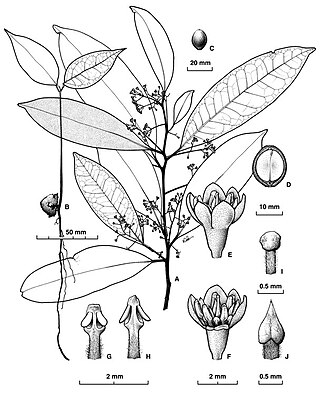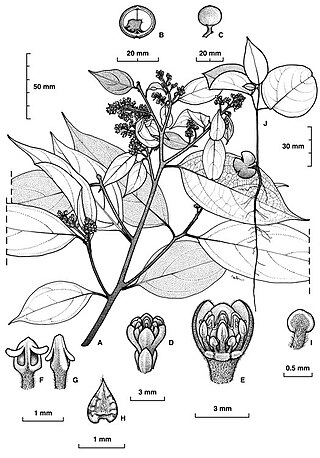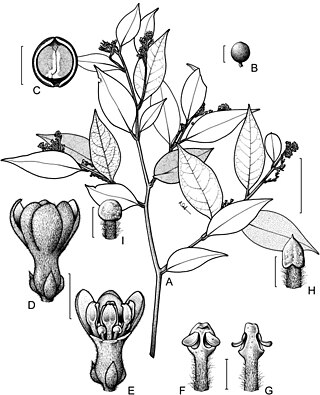
Cryptocarya erythroxylon commonly known as rose maple, rose walnut, pigeonberry ash, red-wooded cryptocarya, southern maple or bottleberry, is a species of flowering plant in the laurel family and is endemic to eastern Australia. Its leaves are elliptic to lance-shaped the flowers cream-coloured and tube-shaped, and the fruit a pear-shaped black drupe.

Cryptocarya foetida, commonly known as stinking cryptocarya or stinking laurel, is a species of flowering plant in the family Lauraceae and is endemic to eastern Australia. It is a small to medium-sized tree with egg-shaped to elliptic leaves, ceam coloured, unpleasantly perfumed, tube-shaped flowers, and spherical black to purplish drupes.

Cryptocarya glaucescens, commonly known as jackwood, is a rainforest tree of the laurel family growing in eastern Australia.

Cryptocarya meissneriana, known as the thick-leaved laurel is a small tree growing in eastern Australia. The habitat is rainforest on the poorer sedimentary soils.

Cryptocarya bidwillii, commonly known as yellow laurel, is a species of flowering plant in the laurel family and is endemic to eastern Australia. Its leaves are lance-shaped to elliptic, the flowers creamy-white and tube-shaped, and the fruit an elliptic black drupe.

Cryptocarya nova-anglica, the mountain laurel, is a rainforest tree growing in eastern Australia. The habitat is a restricted distribution in cool temperate rainforest mostly over 1,100 metres (3,609 ft) in altitude. The range of natural distribution is from the upper Hastings River to near the border of the state of Queensland. It is an understorey tree, associated with the Antarctic beech, possumwood, golden sassafras and black olive berry trees.

Cryptocarya corrugata, commonly known as corduroy laurel, oak walnut, acidwood or bull's breath, is a species of flowering plant in the laurel family and is endemic to north Queensland. It is a tree with egg-shaped to elliptic leaves, the flowers creamy-green, slightly perfumed and tube-shaped, and the fruit a spherical black to bluish-black drupe.

Cryptocarya cunninghamii, commonly known as Cunningham's laurel or coconut laurel, is a species of flowering plant in the laurel family and is endemic to northern Australia. It is a tree with oblong to elliptic leaves, the flowers creamy-green and tube-shaped, and the fruit a spherical black to purplish-blackdrupe.

Cryptocarya angulata, commonly known as ivory laurel, ivory walnut, bull's breath or acidwood, is a tree in the laurel family and is endemic to north Queensland, Australia. Its leaves are lance-shaped to elliptic or egg-shaped, the flowers tube-shaped and creamy-green and the fruit a bluish or black drupe.

Cryptocarya bamagana, commonly known as Bamaga walnut, is a tree in the laurel family and is endemic to Cape York Peninsula. Its leaves are lance-shaped to elliptic or egg-shaped, the flowers cream-coloured and tube-shaped, and the fruit a spherical black drupe.

Cryptocarya bellendenkerana is a tree in the laurel family and is endemic to North Queensland. Its leaves are lance-shaped to egg-shaped, the flowers creamy-green and tube-shaped, and the fruit a spherical black drupe.

Cryptocarya brassii is a species of flowering plant in the laurel family and is native to far north Queensland and Papua New Guinea. Its leaves are elliptic to oblong or lance-shaped, the flowers cream-coloured and tube-shaped, and the fruit an elliptic black to bluish-black drupe.

Cryptocarya burckiana is a tree in the laurel family and is native to Cape York Peninsula in Queensland and to Malesia. Its leaves are lance-shaped to elliptic, the flowers cream-coloured and tube-shaped, and the fruit a spherical black drupe.

Cryptocarya clarksoniana, commonly known as Clarkson's laurel, is a tree in the laurel family and is endemic to north Queensland. Its leaves are lance-shaped to elliptic, the flowers creamy-green and tube-shaped, and the fruit a spherical black drupe.

Cryptocarya claudiana, commonly known as Claudie laurel, is a tree in the laurel family and is endemic to Cape York Peninsula in Queensland. Its leaves are oblong to elliptic, the flowers creamy-green, perfumed and tube-shaped, and the fruit an elliptic or spherical black drupe.

Cryptocarya cocosoides, commonly known as coconut laurel, is a tree in the laurel family and is endemic to north Queensland. Its leaves are lance-shaped to elliptic, the flowers creamy-green, perfumed and tube-shaped, and the fruit a spherical black to purple drupe.

Cryptocarya densiflora, commonly known as cinnamon laurel or white laurel, is a tree in the laurel family and is native to north Queensland and parts of Indonesia. Its leaves are lance-shaped to elliptic, the flowers yellowish-green and brown, tube-shaped but not perfumed, and the fruit is a flattened spherical, reddish maroon drupe that turns black when ripe.

Cryptocarya dorrigoensis, commonly known as Dorrigo laurel, is a species of flowering plant in the laurel family and is native to northern New South Wales. It is a tree with lance-shaped leaves, the flowers greenish-cream to creamy-yellow but not perfumed, and the fruit is a spherical to elliptic, black to bluish-black drupe.

Cryptocarya endiandrifolia, commonly known as narrow-leaved walnut, is a species of flowering plant in the family Lauraceae family and is native to Cape York Peninsula and New Guinea. Its leaves are elliptic to oblong or lance-shaped, the flowers cream-coloured or pale green and unpleasantly perfumed, and the fruit is a spherical to elliptic black drupe.

Cryptocarya exfoliata is a species of flowering plant in the family Lauraceae family and is native to Cape York Peninsula the Northern Territory and New Guinea. Its leaves are lance-shaped, the flowers creamy-green and slightly perfumed, and the fruit is a spherical to elliptic black drupe.




















